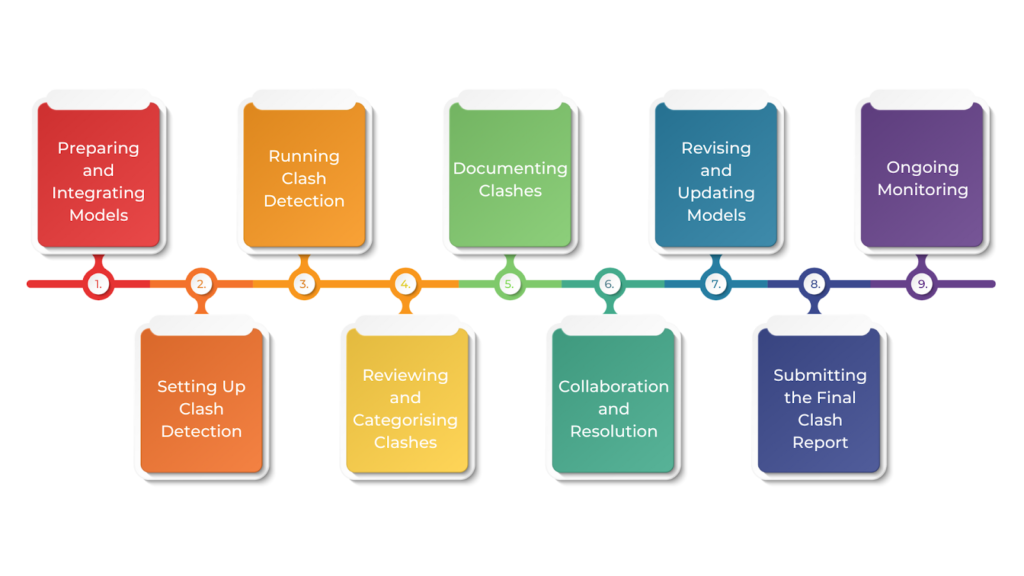Managing clashes effectively is crucial for keeping a construction project on track when using BIM. A well-organised clash report helps teams detect and resolve issues early, preventing costly errors and delays.
From creating and updating reports to tracking their resolution, proper management improves collaboration between architects, engineers, and contractors. Knowing how to generate, import, and maintain clash reports ensures a more efficient and coordinated construction process.
In this article, you will learn about clash reports, how they are created, the procedure of importing them, and managing them effectively.
What is a Clash Report?

A Clash Report is a document used in construction and engineering to spot and record conflicts in a project’s design, usually within a Building Information Modelling (BIM) system. These conflicts, or “clashes,” happen when different systems—like architectural. structural, electrical, or mechanical—overlap in a way that could cause problems during construction.
By identifying these clashes early, project teams can fix them before the construction starts, avoiding costly delays and mistakes. The report typically lists all detected clashes, their severity, and suggested fixes, ensuring everyone involved knows about potential issues and can work together to solve them.
This proactive approach improves efficiency, reduces risks, and helps ensure the final construction matches the design. A clash report also helps keep the project workflow smooth and well-coordinated.
Importance of Clash Report in the BIM Project
In BIM projects, a clash report is more than just a document—it’s an important tool for preventing expensive mistakes before construction begins. Since buildings have many components like walls, columns, beams, stairs, door, slab, ducts, pipes, conduits, and fire protection lines etc running through them, conflicts between these systems are almost unavoidable without proper planning.
A clash report, generated through BIM-based clash detection, helps the project team spot and fix issues early. This prevents delays, extra work, and budget overruns. In project workflows, a clash report helps by:
- Spotting Issues Early: Clash reports help detect conflicts between all three disciplines, their components and systems during the design phase, preventing problems later in construction.
- Avoiding Costly Mistakes: Fixing clashes before construction reduces expensive design changes and rework, saving both time and money.
- Better System Coordination: The report ensures that all components, systems—fit together properly, reducing the risk of overlap or interference.
- Saving Time and Costs: Catching issues early helps keep the project on schedule, avoiding last-minute design changes that could cause delays.
- Encouraging Teamwork: Clash reports improve communication and collaboration between architectural, structural, and MEPF teams, helping them find solutions together.
- Ensuring Safety and Functionality: Resolving clashes in the design phase ensures that systems work safely and efficiently, meeting required standards.
- Smoother Project Execution: Fixing issues before construction leads to a more organised workflow, reducing risks and improving overall efficiency.
Using a Clash Report in the BIM Project workflow leads to better coordination, fewer disruptions, and a more cost-effective project. To get the most out of a clash report, it’s important to understand how it’s created.
Also read: Understanding Clash Detection: Types, Causes, Benefits, and Solutions.
Creation Process of Clash Reports

Creating a clash report is an important part of BIM coordination. The process includes running clash detection in software, sorting the detected clashes, and generating a clear report with actionable insights.
This report points out issues and assigns responsibility, tracks progress, and improves teamwork between architects, engineers, and contractors. A well-prepared clash report makes decision-making easier, reduces rework, and helps keep the project on time and within budget.
Below is a step-by-step approach to creating clash reports:
- Preparing and Integrating Models
Gather BIM models from different teams—architectural, structural, MEPF, site protection. Make sure all models are up-to-date and follow the project design. Upload them to a shared platform like Revit or Navisworks and align them properly. This helps ensure they fit together correctly, making clash detection more accurate.
- Setting Up Clash Detection
Use clash detection software like Navisworks, Revit, or Solibri to find conflicts between building systems. Set rules for detection, like the required space between components and the types of clashes to flag (e.g., structural or functional). This helps avoid unnecessary alerts.
- Running Clash Detection
Run the software to scan the models. It will automatically detect areas where components overlap or interfere. Once the scan is complete, the software creates a list of clashes. Sort them by severity—critical, major, or minor—so the most urgent issues are fixed first.
- Reviewing and Categorising Clashes
Project teams, including architects and engineers, should carefully review each clash to assess its impact and determine the best solution. Clashes are classified into three types:
- Critical Clashes: Major issues that could delay construction or create safety risks.
- Major Clashes: Important problems that need fixing to avoid rework or delays.
- Minor Clashes: Small conflicts that can be adjusted later with little effort.
- Documenting Clashes
Use the clash detection software to generate a detailed clash report. The report should include:
| Clash Report Details | Key Details |
| Clash ID or Reference Number | Unique identifier for tracking |
| Location of the Clash | Where the issue occurs in the model |
| Description of the Conflict | Which systems are involved |
| Severity and Priority Level | How serious is the clash, and how urgently does it need fixing |
| Suggested Solution | Possible ways to resolve the issue |
| Responsible Team | The team in charge of fixing it |
| Timeline for Resolution | The deadline for addressing the clash |
- Collaboration and Resolution
Share the clash report with all project teams so they can review the conflicts and suggest solutions. Experts may recommend rerouting pipes, adjusting spacing, or modifying the design to resolve the clashes.
- Revising and Updating Models
Once the team agrees on solutions, update the BIM models with the changes. Then, run another clash detection scan to ensure the issues are fixed, and no new clashes appear.
- Submitting the Final Clash Report
After fixing all clashes, create a final clash report to confirm the models are clash-free and ready for the next phase. Then, it will be submitted to stakeholders for approval.
- Ongoing Monitoring
Clash detection should continue throughout the construction phase. Regular checks help catch any new conflicts and keep the project running smoothly.
By following these steps, a clash report helps ensure that the project’s design and construction phases run smoothly. Once a clash report is generated, the next step is making it accessible for review and resolution.
Ready to simplify your projects and achieve the benefits?
BIM ASSOCIATES is your one-stop BIM Solution provider for Revit Architectural and Structural Solutions. They coordinate with your team to develop, record, and streamline the BIM Revit Model, along with the sheets, Bill of Quantities, Bill of Materials, and clash coordination.
Procedure for Importing Clash Reports

Importing clash reports is an integral part of BIM coordination. It ensures that all detected conflicts are recorded and addressed properly. This helps project teams analyse clashes, assign responsibilities, and track progress efficiently.
Teams can use the data in coordination meetings and design updates by importing clash reports into software or other project management tools. This process improves stakeholder communication, ensuring issues are resolved quickly and effectively.
Below is a step-by-step guide to correctly importing clash reports for smooth issue resolution and collaboration:
- Prepare the Clash Detection Data
Run clash detection in BIM software to find conflicts in the project models. Once completed, generate a detailed clash report showing all identified issues. Then, export the report in a compatible format such as CSV, XML, or PDF, depending on the project management tool you choose for importing.
- Choose the Right Tool for Importing
Ensure the clash report matches the project management or coordination tool you plan to use, such as Navisworks, BIM 360, Procore, or Trimble Connect. Check if the tool can import clash reports and supports the file format you exported from the Clash Detection software.
- Import the Clash Report
Open the project management or clash resolution tool and look for the import feature (e.g., “Import Clash Report” or “Upload Clash Data“). Click import, select the exported Clash Report file, and follow the prompts to upload it into the software.
- Map the Data Fields
Some tools may ask you to map the report fields (e.g., clash ID, location, severity, and system type) to match the correct fields in the project management system. Ensure accurate mapping to avoid errors or missing data.
- Review and Validate the Data
After importing, check that all clash details—such as descriptions, locations, and severity—are correctly displayed in the system. If there are errors (e.g., missing data or incorrect mapping), adjust the import settings or manually update the information.
- Assign and Prioritise Clashes
Use the project management tool to assign each clash to the responsible team (architects, engineers, or contractors). Prioritise clashes by severity (critical, major, or minor) to ensure urgent issues are fixed first.
- Track Progress and Status
Once clashes are assigned, the tool should allow you to track their progress in resolution. Update the status regularly (resolved, pending, or in progress) so all stakeholders stay informed.
- Reimport Updated Reports (If Needed)
As the project progresses, run new clash detection scans to find any new issues. Reimport the updated clash report and use the project management tool to compare new and previously resolved clashes.
- Generate and Share the Final Report
Once all clashes are resolved, generate a final clash report confirming that the models are clash-free. Share this report with stakeholders to document progress and ensure everyone is updated.
By following these steps, the process of importing and managing clash reports becomes simplified, ensuring that conflicts are addressed in a timely and organised manner.
Importing a clash report is just the beginning. To keep the project on track, teams must continuously manage and update these reports as issues are resolved and new clashes arise.
Managing and Updating Clash Reports
Keeping clash reports updated is important for staying organised and solving conflicts efficiently. As the design changes and clashes get fixed, the report should always show the latest status.
This means tracking which clashes are resolved, setting priorities for unresolved ones, and making sure all teams have the most up-to-date information. A clear process helps prevent miscommunication, speeds up decisions, and keeps clash resolution on track with the project timeline and design needs.
Below is a guide to effectively manage and update clash reports:
- Managing Initial Clash Reports
All clash reports should be stored in one central place, like BIM 360 or Navisworks, so that all team members can access them without hassle. Clashes should be sorted by severity (critical, major, minor) and type (spatial, geometric, functional) to help prioritise which ones to fix first.
Each clash should be assigned to the right team—mechanical, electrical, plumbing, or fire protection—with clear deadlines to resolve it on time.
- Updating Clash Reports During Design and Construction
As the design changes, running clash detection regularly helps catch new issues early. Each update should be recorded with clear IDs and locations, while resolved clashes should be marked properly.
Keeping track of each clash’s status—whether resolved, pending, or in progress—helps keep the team informed. Any changes made to fix clashes, like rerouting ducts or adjusting clearances, should be documented to ensure transparency.
- Communication and Team Collaboration
Regular meetings with designers, engineers, and contractors help review unresolved clashes and find solutions. Project management tools should notify stakeholders about new clashes, updates, or resolutions in real time. Encouraging feedback ensures that solutions are practical and align with project goals.
- Prioritising and Escalating Critical Clashes
Critical clashes that may cause delays, safety risks, or compliance issues should be resolved first. If a clash cannot be addressed within the assigned timeline or requires major changes, escalate it to senior stakeholders or consultants for expert guidance.
- Keeping Track of Changes and Documents
BIM models and clash reports should be version-controlled so everyone works with the latest files. Any changes should be recorded with timestamps to keep things accurate. Saving past reports and resolutions helps track progress, improve efficiency, and settle any disputes if needed.
- Closing Out Clash Reports
Before the project is completed, a final clash report should list all detected clashes, how they were fixed, and their final status. Sharing this report with stakeholders confirms that all issues have been resolved. Once approved, the report and related documents should be safely stored for future reference.
- Learning from the Process
After the project is finished, review the clash management process to find ways for improvement. Lessons learned can be used to fine-tune detection methods, improve communication, and use better tools, making future projects more efficient.
By following these steps, clash reports can be effectively managed and updated, ensuring that potential conflicts are detected early, resolved efficiently, and documented accurately.
BIM Supports GREEN EARTH.
Conclusion
Clash reports are important in modern construction and building design because they help teams find and fix issues in BIM models. Catching clashes early prevents costly mistakes and delays during construction.
When linked to project management systems, these reports make teamwork easier and help track progress in real time. Using clash reports effectively improves coordination, keeps projects on schedule, and reduces risks, leading to a smoother and more successful construction process.
Are you looking for BIM solutions?
BIM ASSOCIATES is your one-stop BIM Solution provider for the Architecture and Structure discipline. Their solutions help clients with better decision-making, cost-saving, efficient construction planning, and green earth initiatives.
You might also like: BIM Levels in Construction: Maturity, LOD, Dimensions, & Future Trends.
FAQs (Frequently Asked Questions)
1. What is a clash in BIM?
A clash in BIM happens when parts of a building overlap or get in each other’s way in a 3D model. For example, a pipe going through a beam or a duct blocking a doorway. If not fixed before construction begins, clashes can lead to delays, mistakes, and extra costs.
2. What is a clash test?
A clash test in BIM checks if different building parts overlap or collide in a design. Software like Navisworks or BIM 360 scans the model to find these clashes. Fixing issues early helps teams save time and money during construction.
3. What is clash analysis?
Clash analysis is the process of reviewing and managing clashes found in a BIM model. It includes sorting clashes by type and severity, assigning them to the right teams, and tracking their resolution. The main goal is to fix all issues before construction starts.
4. What are the different types of clashes?
There are three main types of clashes in BIM:
- Hard Clash: When two objects physically overlap, like a beam cutting through a duct.
- Soft Clash: When components are too close, violating clearance or safety requirements.
- Workflow Clash: When scheduling or installation issues cause conflicts like two teams are required to work in the same space at the same time.

